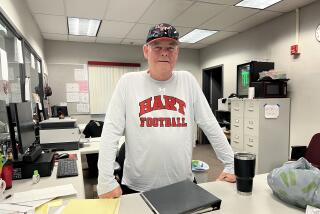Heart Disease Killed Herrion
- Share via
The heart condition that led to the death of San Francisco 49er lineman Thomas Herrion probably would not have been detected even with sophisticated tests that some cardiologists have urged the NFL to adopt, doctors said Tuesday.
Herrion, who collapsed after an exhibition against the Denver Broncos last month, died of heart disease, the Denver County coroner’s office reported Tuesday.
Herrion, 23, had a significant blockage in his right coronary artery that caused the death of heart muscle, according to the report. He had a slightly enlarged heart, and the only drug discovered in his system was atropine, used by medical personnel trying to revive him.
The league and the players’ union have not received the complete report but plan to review the findings, according to NFL spokesman Greg Aiello and NFL Players Assn. medical director Dr. Thom Mayer.
“Based on what we know so far, this may be a case of an unfortunate hereditary condition that is not easily detected even by the regular and thorough cardiac screening used by NFL clubs,” Aiello said in a statement. “Unfortunately, even young people can be struck without warning by a heart attack.”
Herrion had ischemic heart disease, in which narrowing of the arteries results in the diminished flow of blood and oxygen to reach the heart muscle. The autopsy showed evidence that restricted blood flow had resulted in the death of some heart muscle “a week or so” before Herrion collapsed, according to deputy coroner Amy Martin.
“Whether he was aware of that was not clear,” Martin said. “There are a lot of instances where people have heart attacks and are not aware of them, especially when your jobs require you to do things that require you to get hurt.”
Some cardiologists take issue with what Aiello called the “thorough cardiac screening used by NFL clubs.” An electrocardiogram (EKG), in which electrodes put atop the chest can suggest basic heart abnormalities, is the only cardiac test mandated as part of an NFL physical examination. Stress tests can be ordered at the doctor’s discretion.
The exam does not include more sophisticated non-invasive cardiac tests, including an echocardiogram, MRI and CT scan. But Mayer said Herrion’s condition would have been revealed only by a cardiac catheterization, a procedure in which a tube is threaded from the groin into the heart, then pumped with dye to show any narrowing of the arteries and impediments to blood flow.
“With a high degree of certainty, I can say, short of cardiac catheterization, nothing would have shown this,” Mayer said. “An EKG would not show that. An MRI or CT would not show that. A stress test would not show that. The only thing that would have shown that would have been a cardiac catheterization.
“That’s not a screening that anyone would recommend for someone who is previously asymptomatic and 23 years old.”
Cardiologists unaffiliated with the league or the union agreed that Herrion’s condition probably would not have been detected even with the newer cardiac tests but said the NFL should be using them anyway.
An EKG costs about $50 and takes about one minute, said Mark Zatzkis of the Pacific Heart Institute in Santa Monica. The newer tests cost $500 to $800, but he said they can “pick up all kinds” of heart disease that might go undetected by an EKG.
Those costs would make the screening of high school and college athletes prohibitively expensive, particularly since so few tests would turn up positive among young people and about 10% of those that do would turn out to be false alarms that could result in even more expensive follow-up exams, said Douglas Zeites, past president of the American College of Cardiology and professor at the Indiana University School of Medicine.
“At a professional level, I would think the team would be interested enough in their investment to screen their athletes more intensively,” he said.
Zatzkis recommends an EKG and echocardiogram for “elite athletes” whose sports demand maximum exertion. He suggests players, not just management, might be unenthusiastic about additional tests.
“The athletes don’t want them to be done. They are about as happy to see a cardiologist as airline pilots are,” he said. “They view us as people who can only give them bad news.”
Herrion weighed 335 pounds, not excessive for an NFL lineman. Obesity is a risk factor for heart disease -- but so are high blood pressure, diabetes, smoking, family history, and the use of supplements, including ephedra, Zeites said.
All players should be tested, he said, left tackles and left cornerbacks alike.
“I wouldn’t just look at obese linemen,” he said.
The requirements for an NFL physical examination are included in the collective bargaining agreement between management and the union. The sides consult regularly on medical issues, Mayer said, and plan to discuss whether to mandate additional cardiac tests for players.
The players would be concerned with how the results could be used, he said. For instance, Mayer said, could a team cut a player whose test revealed a 20% blockage of a coronary artery even though that player’s heart would be functional?
“We are certainly moving toward ways to find out more about the cardiac status of patients,” Mayer said. “The different imaging procedures are there.
“That said, in this particular player’s case, it would not have made a difference.”
*
Associated Press contributed to this report.
More to Read
Go beyond the scoreboard
Get the latest on L.A.'s teams in the daily Sports Report newsletter.
You may occasionally receive promotional content from the Los Angeles Times.











